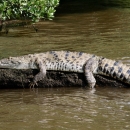The Water Resources Development Acts of 1992 and 1996 provided the U.S. Army Corps of Engineers (Corps) with the authority to review the Central and Southern Florida Project.
In the 1990s, Congressed directed the U.S. Army Corps of Engineers (Corps) to develop a comprehensive plan to restore and conserve south Florida's natural ecosystem while enhancing water supplies and maintaining flood protection. In partnership, the Corps and South Florida Water Management District (District) worked over six years with more than 100 ecologists, hydrologists, engineers and other professionals from more than 30 Federal, state, tribal, and local agencies to take a system-wide look at water in south Florida.
The Service worked with these partners to find opportunities to help conserve south Florida’s rarest plants and animals and identify and minimize any detrimental impacts to those species that might result from the Everglades restoration effort. The Corps and the District, with support from partners, developed a master plan laying out the process to be used for managing and monitoring Everglades restoration. The master Plan covers six pilot projects and 56 restoration plan components for which the District has agreed to be the local sponsor.
Working under the authorities of the Fish and Wildlife Coordination Act, Endangered Species Act, Migratory Bird Treaty Act, Clean Water Act, and the National Environmental Policy Act. the U.S. Fish and Wildlife Service is working to assure that the Everglades restoration provides maximum benefits to the diverse fish and wildlife resources of south Florida.




